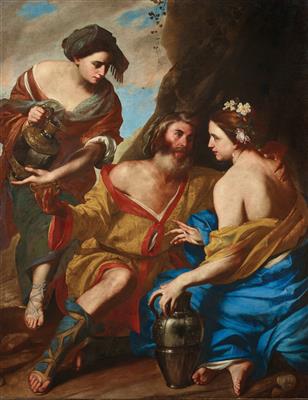Massimo Stanzione

(Orta di Atella circa 1585 – circa 1656 Naples)
Lot and his daughters,
signed with an entwined monogram lower right: EQ. MAX./NE…,
oil on canvas, 166.5 x 130.5 cm, framed
Provenance:
European Private collection (acquired by the grandfather of the present owner)
We are grateful to Sebastian Schütze for confirming the attribution after examining the present painting in the original.
This unpublished painting is an important addition to the oeuvre of Massimo Stanzione. The work is signed on a stone, lower right with the artist’s typical entwined monogram: the first two letters refer to the title of ‘cavaliere’ which was given to him on three different occasions during the 1620s, witness to the undisputed social prestige he attained. The specification of his status as a Neapolitan might indicate that this painting was to be sent beyond Naples, and perhaps even beyond the borders of Italy, as was the case for his Bacchanal painted for Phillip IV for the Palazzo del Buen Retiro (and now in the Museo del Prado, Madrid) which is similarly signed.
The biblical subject of Lot and his daughters was frequently represented in Neapolitan painting during the first half of the seventeenth century, and Stanzione depicted it on at least two other occasions: one now in the Pinacoteca Nazionale, Cosenza (see N. Spinosa, Pittura del Seicento a Napoli da Caravaggio a Massimo Stanzione, Naples 2010, p. 409, no. 436) and another is in the Musée des Beaux-Arts et d’Archéologie, Besançon (see S. Schütze and T. Villette, Massimo Stanzione. L’opera completa, Naples 1992, p. 230, no. A81). The present painting differs from the other known versions for its vertical format, wherein the scene is exclusively dominated by the three elegantly dressed figures wearing brightly coloured robes, set in contrast to the sombre rocky landscape background.
The work belongs to the artist’s full maturity, and specifically to the early 1640s. During this period, Stanzione, who was already involved in the main commissions in Naples begun in the previous decade, and he was active at many sites, largely for ecclesiastical patrons. For example, he executed the frescoes for the Chiesa del Gesù Nuovo, those in San Paolo Maggiore, and those in Santa Maria Regina Coeli.
It was in Rome during the second decade of the seventeenth century that Stanzione absorbed both the realism of Caravaggio and that Emilian classicism of Annibale Carracci and Guido Reni, thereby managing to formulate a fusion of both styles to create a pictorial language entirely his own, the success of which made him one of the most sought after and distinguished painters of his age.
Esperto: Mark MacDonnell
 Mark MacDonnell
Mark MacDonnell
+43 1 515 60 403
oldmasters@dorotheum.com
09.06.2020 - 16:00
- Prezzo realizzato: **
-
EUR 393.700,-
- Stima:
-
EUR 200.000,- a EUR 300.000,-
Massimo Stanzione
(Orta di Atella circa 1585 – circa 1656 Naples)
Lot and his daughters,
signed with an entwined monogram lower right: EQ. MAX./NE…,
oil on canvas, 166.5 x 130.5 cm, framed
Provenance:
European Private collection (acquired by the grandfather of the present owner)
We are grateful to Sebastian Schütze for confirming the attribution after examining the present painting in the original.
This unpublished painting is an important addition to the oeuvre of Massimo Stanzione. The work is signed on a stone, lower right with the artist’s typical entwined monogram: the first two letters refer to the title of ‘cavaliere’ which was given to him on three different occasions during the 1620s, witness to the undisputed social prestige he attained. The specification of his status as a Neapolitan might indicate that this painting was to be sent beyond Naples, and perhaps even beyond the borders of Italy, as was the case for his Bacchanal painted for Phillip IV for the Palazzo del Buen Retiro (and now in the Museo del Prado, Madrid) which is similarly signed.
The biblical subject of Lot and his daughters was frequently represented in Neapolitan painting during the first half of the seventeenth century, and Stanzione depicted it on at least two other occasions: one now in the Pinacoteca Nazionale, Cosenza (see N. Spinosa, Pittura del Seicento a Napoli da Caravaggio a Massimo Stanzione, Naples 2010, p. 409, no. 436) and another is in the Musée des Beaux-Arts et d’Archéologie, Besançon (see S. Schütze and T. Villette, Massimo Stanzione. L’opera completa, Naples 1992, p. 230, no. A81). The present painting differs from the other known versions for its vertical format, wherein the scene is exclusively dominated by the three elegantly dressed figures wearing brightly coloured robes, set in contrast to the sombre rocky landscape background.
The work belongs to the artist’s full maturity, and specifically to the early 1640s. During this period, Stanzione, who was already involved in the main commissions in Naples begun in the previous decade, and he was active at many sites, largely for ecclesiastical patrons. For example, he executed the frescoes for the Chiesa del Gesù Nuovo, those in San Paolo Maggiore, and those in Santa Maria Regina Coeli.
It was in Rome during the second decade of the seventeenth century that Stanzione absorbed both the realism of Caravaggio and that Emilian classicism of Annibale Carracci and Guido Reni, thereby managing to formulate a fusion of both styles to create a pictorial language entirely his own, the success of which made him one of the most sought after and distinguished painters of his age.
Esperto: Mark MacDonnell
 Mark MacDonnell
Mark MacDonnell
+43 1 515 60 403
oldmasters@dorotheum.com
|
Hotline dell'acquirente
lun-ven: 10.00 - 17.00
old.masters@dorotheum.at +43 1 515 60 403 |
| Asta: | Dipinti antichi |
| Tipo d'asta: | Asta in sala |
| Data: | 09.06.2020 - 16:00 |
| Luogo dell'asta: | Wien | Palais Dorotheum |
| Esposizione: | 02.06. - 09.06.2020 |
** Prezzo d'acquisto comprensivo di tassa di vendita e IVA
Non è più possibile effettuare un ordine di acquisto su Internet. L'asta è in preparazione o è già stata eseguita.
